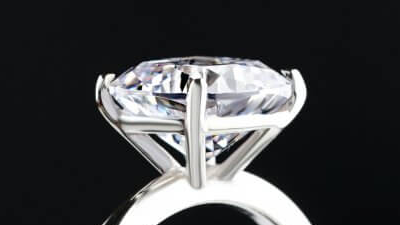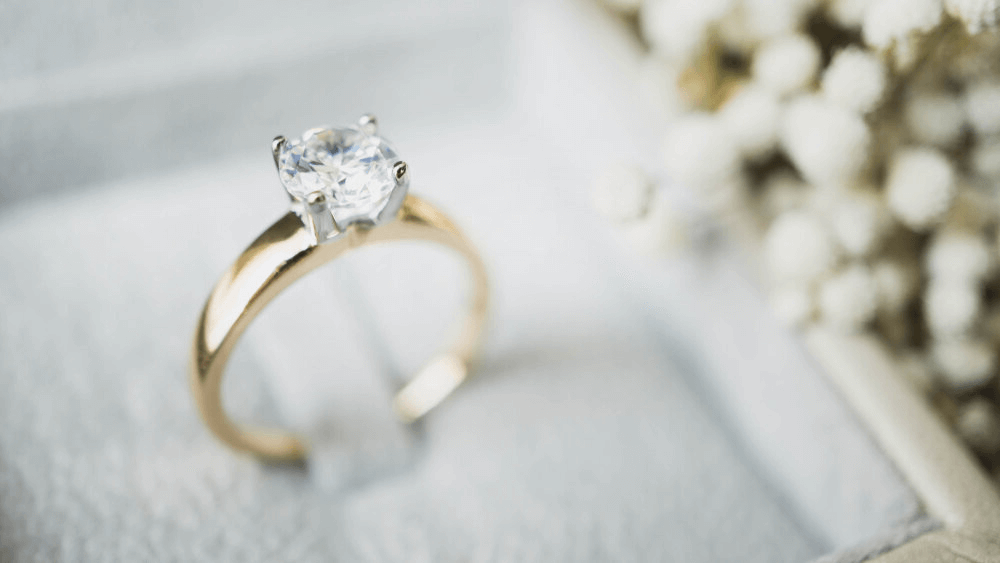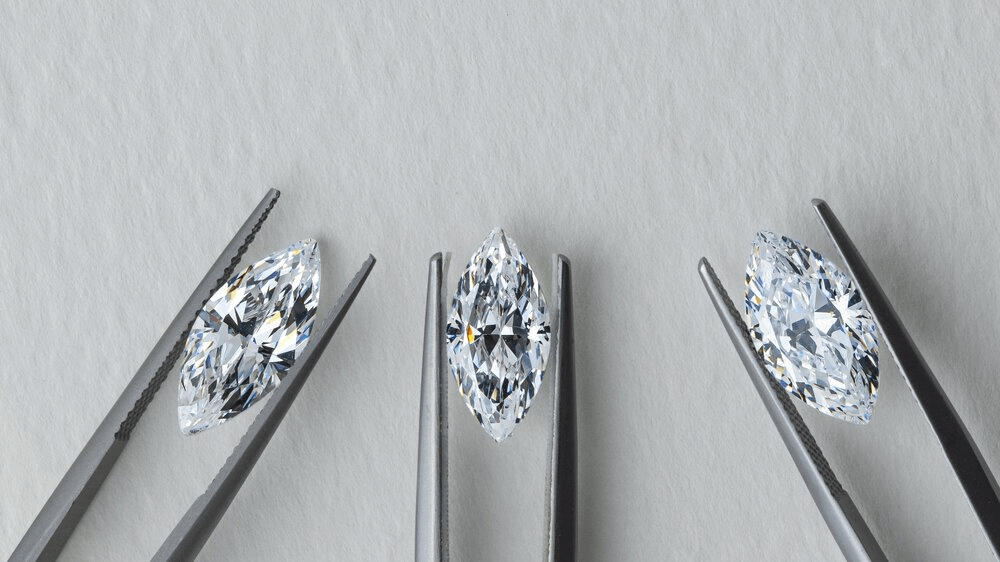Girdle Hacks to Enhance Diamond Brilliance

By Gary A.

Edited by Olivia H.
Published Mar 26, 2022
Edited on Mar 31, 2025
When choosing the perfect diamond, the often-overlooked diamond girdle plays a vital role in both durability and appearance, ensuring your stone stands the test of time while maximizing its sparkle.

Navigate This Guide:
- 6 Quick Tips for Examining Diamond Girdle When Buying an Engagement Ring
- Introduction to Diamond Girdles
- Types of Girdle Finishes
- Diamond Girdle Location
- The Diamond Girdle’s Role for Durability
- Impact on Appearance – the Girdle Reflection
- Girdle Thickness: Striking the Right Balance
- Our Expert Take
- 9 FAQs
Before we dive deeper into the specifics, here are some practical tips to help guide your decision-making process:
6 Quick Tips for Examining Diamond Girdle When Buying an Engagement Ring
- Tip 1:Understanding Girdle Thickness Assess Girdle Thickness: Check the diamond’s certificate for the girdle thickness, which is typically listed as a range (e.g., Thin to Medium). Ideal thickness varies by diamond shape, but generally, a Thin to Slightly Thick girdle is preferable for most shapes.
- Tip 2:Inspecting Girdle Finish Examine the Girdle Finish: Look closely at the diamond’s girdle to determine if it’s faceted, polished, or bruted. A faceted girdle, with its small, flat surfaces, can enhance the diamond’s appearance, making it a desirable feature.
- Tip 3:Check for Uniformity and Symmetry Evaluate Girdle Uniformity: A well-cut diamond should have a relatively uniform girdle. Extreme variations in girdle thickness can indicate poor cut quality and affect the diamond’s symmetry and balance.
- Tip 4:Girdle Reflection and Transparency Observe for Girdle Reflections: Girdle reflections can sometimes be mistaken for cracks or inclusions. A good quality diamond should not have prominent girdle reflections that impact its transparency and brilliance.
- Tip 5:Impact on Durability Consider the Girdle’s Durability: A very thin girdle might make the diamond prone to chipping, especially on the edges. Conversely, a very thick girdle might add unnecessary weight and affect the diamond’s proportions.
- Tip 6:Proportion and Aesthetic Appeal Assess Proportions and Aesthetics: The girdle’s thickness should complement the diamond’s overall proportions. It should not be so thick as to make the stone appear smaller or so thin that it compromises the structural integrity of the diamond.
Now that you’ve got these practical tips, use Jeweler AI below to find the perfect engagement ring that suits your style and budget:
Introduction to Diamond Girdles
Along with grades for Cut, Symmetry, and Polish, your GIA diamond report will also include a ‘grade’ for the stone’s culet – which you can read more about here – and for its girdle. And, while these details aren’t given the same level of importance as some of the more obvious features, it’s still important that you know how to interpret them.
A diamond’s girdle can make or (quite literally) break it, so here’s what you need to know.
Diamond Girdle Meaning
The girdle is represented by a thin line running along the circumference or perimeter of the diamond, where the crown and the pavilion meet.
While, from a distance, the girdle may appear to be a sharp line dividing the upper portion of the diamond from the lower portion, its size and weight actually vary across the length of the girdle.
These variances are referred to as valleys and hills and aren’t a sign of a poor cut. They’re there to protect what is one of the most vulnerable parts of the diamond from chipping.
This is why the girdle features its own grade in the report – because, just like any other aspect of cut quality, there is a ‘sweet spot’ shoppers should always aim to fall into.
Keep in mind that, as with diamond proportion and ratio, the ideal range for a particular shape will differ from the ideal range for a different shape.
Structural Role
It’s there to offer some protection to the diamond, particularly during the process of setting it within jewelry.
Like the culet, a sharp point can be more prone to breaking. As a result, both the culet and the girdle may be thickened to ensure more protection to the stone during its transferal into the ring, and throughout its lifetime on the wearer’s finger.
A thicker girdle does not cause as much disruption to the diamond’s appearance as a culet, but even so, thinner girdles are generally considered the preferable option.

Types of Girdle Finishes
Faceted Girdles
These girdles showcase small, flat surfaces that add a touch of sparkle and decorative flair to a diamond. These intricately cut facets contribute to the overall brilliance and visual appeal of the stone. The light-play created by a faceted girdle can enhance the diamond’s radiance, making it a sought-after feature for those who appreciate a touch of elegance in their jewelry.
Polished Girdles
Polished girdles feature a smooth and clear appearance, contributing to the diamond’s overall sleekness. This finish provides a seamless transition between the crown and pavilion, creating a polished, refined look. The smooth surface reflects light uniformly, accentuating the diamond’s brilliance and maintaining a sophisticated aesthetic.
Bruted Girdles
Bruted girdles feature a frosted, textured appearance, adding a unique touch to the diamond’s overall character. This finish is achieved by grinding the girdle’s surface, creating a distinctive, matte effect. While it may lack the sparkle of faceted or the clarity of polished girdles, the bruted finish contributes to a more distinctive and vintage look. This rustic charm appeals to individuals seeking a diamond with character and a touch of historical allure in their jewelry.
Diamond Girdle Location
Look at a diamond side-on, then follow the pavilion from the base (culet) to its widest point. That’s where you’ll find the girdle.

The Diamond Girdle’s Role for Durability
When cut too thinly, a girdle represents a major weak spot on the diamond. Cut too irregularly, and the diamond may suffer from poor symmetry. Too thick, and you may find the diamond suffers from ‘girdle reflection’, which will appear as a grey cast visible through the table.
The girdle isn’t a particularly valued part of the diamond’s appearance. Once mounted in a ring, there’s a strong chance you and the wearer will barely notice it. Still, it’s a mistake to presume that it’s a non-issue, or that the best diamonds are simply those with the least noticeable (or, in other words, thinnest) girdles.
In shapes featuring sharp points, for instance, like the Pear and Marquise, it’s considered a mark in their favor if the girdle is slightly thicker since it offers a little extra protection to the weakest part of the cut.
Impact on Appearance – the Girdle Reflection
Girdle reflection is a result of a girdle cut far too thick, meaning that too much of the diamond’s weight is contained within this part of the diamond and, as a result, light can’t travel in and out of the diamond along the optimal path.
Instead, some light winds up escaping through the girdle itself. At the same time, an overly thick girdle can throw off the rest of the diamond’s proportions, making it a very poor choice in terms of light performance (sparkle). This is also known as a ‘fisheye’ and is indicative of a low-quality cut.
Identifying and Addressing Girdle Reflections
Girdle reflections are relatively easy to spot – a fact that should come as a strong reassurance to anyone preparing to buy a diamond. Nevertheless, you’ll want to read the specifications in the GIA report for yourself, and ensure you’re shopping from a vendor that holds a very high standard for the diamonds they sell – like us!
Girdle Reflection vs. Cracks
A slight girdle reflection is preferable to a crack. Once a diamond has sustained a crack there is no way of undoing that damage. In some cases, the owner of the diamond might choose to have it recut or repolished but doing so will inevitably lead to the loss of considerably more of the diamond’s original carat weight.
A chip also makes the diamond more vulnerable to sustaining more damage. This is why it is so important that a diamond’s girdle is not cut too thin. While the profile may look good, it’s an accident waiting to happen – particularly if you plan on wearing the diamond with any regularity.
Girdle Thickness: Striking the Right Balance
This part of the diamond can be good or bad, depending on how thick the girdle is. An extremely thick girdle can, as we mentioned, cause an unsightly girdle reflection, but a girdle of moderate thickness is often seen as ideal.
The GIA’s scale utilizes the following grades:
- Extremely thin
- Very thin
- Thin
- Medium
- Slightly thick
- Thick
- Very thick
- Extremely thick
In your report, you will typically find two grades listed alongside one another – for instance, ‘Very Thin to Slightly Thick’ – which identify the thinnest points (valleys) and thickest points (hills) of the girdle.
For instance, the ideal girdle for a Round diamond is Thin – Slightly Thick, while either extreme – extremely thin or extremely thick – is a poor investment.
Our Expert Take
The ideal diamond girdle thickness for any diamond depends on its shape, but a more general answer to this question will always be ‘not too thin, and not too thick’.
While that may seem like a vague, Goldilocks answer to a pretty important question, the key is to do your research into your chosen diamond shape. Each shape has its own ideal ranges for table, depth, length-to-width ratio, and learning these means being able to look beyond the grades for Cut, Symmetry, and Polish, and ensure that your diamond’s light performance is the very best it could be.
As we mentioned at the beginning of the article, the girdle isn’t generally seen as one of the most important considerations for shoppers since the accepted ranges are generally pretty wide, and it only tends to pose a major problem for the diamond in extreme cases (either extremely thin, or extremely thick). Nevertheless, don’t take that as a sign that you can overlook the girdle entirely.
9 FAQs
- Q: What is a Diamond Girdle?
- A: The diamond girdle is the narrow rim around the widest part of a diamond, serving as the boundary between the top (crown) and bottom (pavilion) of the stone.
- Q: Why is Girdle Thickness Important?
- A: Girdle thickness affects a diamond’s durability and appearance. Too thin, it’s prone to chipping; too thick, it may weigh more and impact brilliance.
- Q: What are the Different Types of Girdle Finishes?
- A: Diamond girdles can be faceted (decorative and sparkly), polished (smooth and clear), or bruted (frosted appearance).
- Q: How Does Girdle Reflection Affect a Diamond?
- A: Girdle reflection can sometimes mimic internal cracks but is generally not a flaw. It affects the diamond’s appearance, particularly under certain lighting.
- Q: Can Girdle Imperfections be Fixed?
- A: Minor imperfections like small chips can be polished, but significant damage might require recutting the diamond, potentially altering its carat weight.
- Q: How is Girdle Evaluated in Diamond Grading?
- A: Grading reports assess girdle thickness and finish as part of the diamond’s overall cut grade, impacting its symmetry and light performance.
- Q: What is the Ideal Girdle Thickness?
- A: Ideal girdle thickness varies by diamond shape. Generally, “Thin to Medium” is suitable for most shapes, with “Slightly Thick” preferred for pointed shapes like marquise or pear for added protection.
- Q: Does a Thicker Girdle Mean a Better Diamond?
- A: Not necessarily. While a thicker girdle can offer more protection, it can also add extra weight and potentially diminish the diamond’s brilliance.
- Q: Can Girdle Thickness Affect Diamond Price?
- A: Yes, as it impacts the diamond’s cut grade and overall visual appeal, which are critical factors in determining its market value.
Discover the perfect diamond with Jeweler AI – where the girdle’s secret to brilliance is just a click away!
FOLLOW-UP GUIDE SERIES












